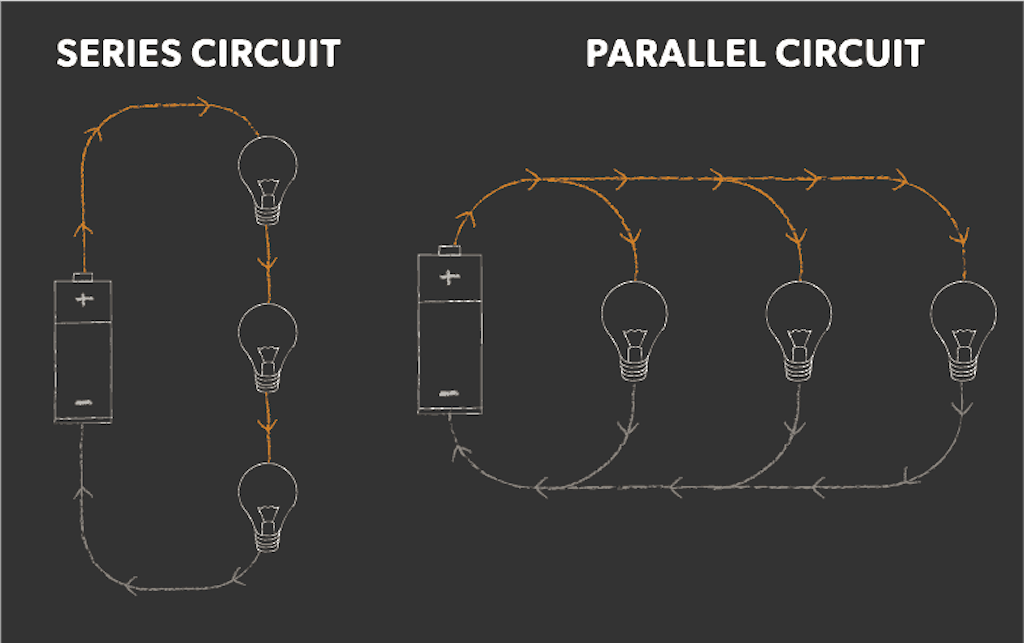Deep Cycle Batteries: How to Keep Them Alive for Years and Years
Lead-acid deep cycle batteries are often considered to be the “weak link” in renewable energy systems. However, today’s renewable energy batteries are better than ever, and so are the devices that regulate and protect them. Battery failures are rarely the fault of the batteries themselves! Follow these guidelines to avoid the vast majority of all battery problems.
Sizing Battery Banks
A battery bank should be sized (as a minimum) to a capacity of 5 days of load. Energy use in most home power systems increases over time, so consider sizing larger than that. Why? After 1 year of service, it is NOT advisable to enlarge a battery bank by adding new batteries to it, because batteries’ voltage response changes with age. Stray currents flow, causing losses and failure to equalize.
A PV array, if it is the primary energy source, should be sized to produce (on average) 30% more energy than the load requires. This compensates for battery losses and for less-than-average charging conditions. Luckily, a PV array can be expanded at any time.
Buy high-quality batteries selected for your needs. You get what you pay for! Good deep-cycle batteries can be expected to last for 5 to 15 years, and sometimes more. Cheap batteries can give you trouble in half that time. Read our cost comparison of lead-acid and lithium batteries for more info.
Avoid multiple parallel strings
The ideal battery bank is the simplest, consisting of a single series of cells that are sized for the job. Higher capacity batteries tend to have thicker plates, and therefore greater longevity. Having fewer cells will reduce the chance of randomly occurring defects, and reduces maintenance. Suppose for example, that you require a 700 Amp-Hour bank. You can approximate that by using 3 parallel strings of golf-cart batteries (220 AH), or 2 strings of the larger L-16 style batteries (350 AH) or a single string of larger, industrial batteries.
Under no circumstances is it advisable to install more than three parallel battery strings. The resulting bank will tend to lose its equalization, resulting in accelerated failure of any weak cells. Weak cells will be difficult to detect because they will “steal” from the surrounding cells, and the system will suffer as a whole and will cost you more in the long run.
Here are some precautions to take when wiring two or more strings of batteries in series-parallel. The goal is to maintain all of the cells at an equal state of charge. Cells that tend to receive less charge are likely to fail prematurely. This can take years off of the effective life of the battery bank. A fraction of an ohm of added resistance in one battery string can reduce the life of the entire string.
Step one: Connect the two main cables to opposite corners of the battery bank, and maintain symmetry in wire size and lengths. This will help to distribute current evenly through the bank.

Step two: Arrange batteries to maintain even temperature distribution throughout the bank. Avoid uneven exposure to heat sources. Leave at least 1/2 inch of air space around each battery, to promote even cooling.
Step three: Apply a finish charge at least every 3 weeks (bring every cell to 100% charge).
Prevent corrosion
In flooded battery installations, corrosion of terminals and cables is an ugly nuisance that causes resistance and potential hazards. Once corrosion gets hold, it is hard to stop. The good news — it is easy to prevent! Apply a non-hardening sealant to all of the metal parts of the terminals before assembly. Completely coat the battery terminals, the wire lugs, and the nuts and bolts individually. A sealant applied after assembly will not reach all around every junction. Voids will remain, acid spatter will enter, and corrosion will begin as soon as your installation is finished.
Special compounds are sold to protect terminals, but you can have perfectly good results using common petroleum jelly (Vaseline). It will not inhibit electrical contact. Apply a thin coating with your fingers, and it won’t look sloppy. If wire is exposed at a terminal lug, it should be sealed airtight, using either adhesive-lined heat-shrink tubing or submersible rubber splice tape. You can also seal an end of stranded wire by warming it gently, and dipping it in the petroleum jelly to liquefy, and wick it into the wire.
It also helps to put the batteries over a floor drain, or in a space without a floor, so that they can be rinsed with water easily. Washing the battery tops (about twice per year) will remove accumulated moisture (acid spatter) and dust. This will further reduce corrosion, and will prevent stray currents from stealing energy. Batteries that we have protected by these measures show very little corrosion, even after 10 years without terminal cleaning.
Moderate the temperature
Batteries lose approximately 25% of their capacity at a temperature of 30°F (compared to a baseline of 77°F). At higher temperatures, they deteriorate faster. Thus, it is desirable to protect them from temperature extremes. If no thermally-stable structure is available, consider an earth-sheltered enclosure. Where low temperature cannot be avoided, get a larger battery bank to make up for the loss of capacity in the winter. Avoid direct radiant heat sources that will cause some batteries to get warmer than others.
Use temperature compensation
When batteries are cold, they require an increase in the charge voltage limit, in order to reach full charge. When they are warm, they require a reduction in the voltage limit in order to prevent overcharge. Temperature compensation is a feature in many charge controllers and power centers, as well as in the back-up chargers in some inverters. To use this feature, order the accessory temperature probe for each charging device, and attach it to any one of the batteries.
Use low-voltage disconnects
Discharging a battery to exhaustion will cause immediate, irreversible loss of capacity and life expectancy. Your system should employ low voltage disconnect (LVD) in the load circuits. Most dc to ac power inverters have this feature, and so do many charge controllers and power centers. Don’t depend on human behavior to prevent over-discharge. It can be caused easily by accident or by an irresponsible user. Again, most inverters have LVD built-in but if there are DC loads on the system, please incorporate an LVD device.
Bring batteries to a full state-of-charge every 3 weeks
Bring the batteries to a full state-of-charge (SOC) at least every 3 weeks. This reduces internal corrosion and degradation, and helps to insure equalization, so that any weaker cells do not fall continually farther behind. A full SOC may occur naturally during most of the year, but do not hesitate to run a generator when necessary, to bring the batteries up. Information like this should be posted at the power center. For more details, refer to the instructions for the inverter/charger and for the batteries.
How do you know when a battery is 100% charged?
The “charged” indicator on most PV charge controllers means only that battery voltage is relatively high. The SOC may be approaching full, but is not necessarily near 100% A voltmeter reading gets you closer, but it is not a certain indicator. It varies too much with current flow, temperature and time, to give a clear indication.
For flooded batteries, a hydrometer is the definitive indicating device, although not a convenient one. With it, you can measure every cell individually. Obtain one from a battery or automotive supplier. Even the cheapest hydrometer is fine. Rinse it after use, and keep it clean. An amp-hour meter is the most informative and user-friendly way to monitor SOC. For sealed batteries, it is the ONLY definitive method. See next paragraph.
Install a System Monitor
Would you drive a car with no dashboard? Metering is not just “bells and whistles”. It is necessary to help you to read the status of the system. Many charge controllers have indicator lights and readouts built-in. For a full-scale remote home, consider the addition of a digital monitor, like Trace TM-500, Tri-Metric, E-Meter or Omni-Meter. These devices monitor voltage and current, record amp-hours, and accurately display the state-of-charge of the battery bank. They also record more detailed information that can be useful for troubleshooting. The monitor may be mounted in another room or building, for handy viewing.
How to read a Hydrometer
A hydrometer will help you to determine whether the battery bank is getting fully charged, and whether any individual cells are falling behind. You should be aware that a hydrometer will give you false readings under the following conditions.
After adding water: For pure water to mix throughout the cell, it takes time and some bubbling during finish charge. A hydrometer will show a greatly reduced reading until the fluid mixes.
Low temperature: As battery temperature drops, the fluid becomes more dense. A temperature compensating hydrometer is best. Otherwise, for every 10°F below 70°F, subtract 3.5 points from the reading.
Time lag during recharge: As the battery recharges, the fluid becomes more dense down between the plates. The hydrometer reads the fluid above the plates. You will get a delayed reading until the fluid is mixed by the movement of bubbles during finish charge. The voltage will rise steadily, providing an indication that something is happening.
During discharge, you will get a true hydrometer reading because the fluid becomes less dense and will circulate to the top. Any time a hydrometer indicates a fully charged cell, you know it is fully charged.
Warning: battery acid is hazardous. When working around batteries, wear safety glasses. Get a rugged plastic bottle to keep with your service tools, and fill it with a sodium bicarbonate (baking soda) and water. Use it to neutralize accidental splash or spills and to clean normal acid spatter from battery tops. Finally, don’t wear your favorite blue jeans!
Just add water
Note: This applies only to “flooded batteries”, not to “sealed batteries”.
The plates of every cell in your battery bank must be submerged at all times. Never add any fluid to a battery except distilled water, deionized water, or very clean rainwater collected in plastic containers. Most batteries require addition of water every 6 to 12 months. There is no need to fill them more frequently than needed to submerge the plates. Fill them only to the level recommended by the manufacturer, generally about an inch below the top, otherwise they may overflow during finish-charging.
Conclusion
Deep cycle batteries are the heart of your power system. They may demand your attention occasionally, but your relationship with them need not be a struggle. With a proper installation, a little understanding and some simple maintenance, your batteries will live a long and healthy life. At Unbound Solar, we will be happy to help find the products that are right for you. For pricing and product information give us a call. We’ll also answer any questions you might have about your system. 1-800-472-1142

